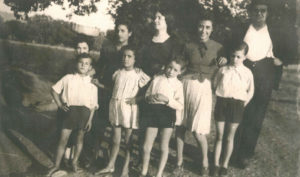
The Crocco family tree has an anchor as its emblem, its roots can be traced back to the maritime city of Genoa. The people of Genoa profited by purchasing, in feudal times, palaces and estates in areas as far as Basilicata, thus entering into the noble class.
In the medieval epoch, Pietro Crocco, was an expert apothecary: Prince Berardino always kept him by his side, esteeming him for his culture and reliability. By way of compensation for his services, he entrusted him with many arable lands in the territory of Senise.
In 1714 Giambattista Crocco was mayor of Senise. Successively in 1737, the same role will be held by the notary Andrea Crocco.
Notary Andrea, in this period, possessed: sixty stretches of land on the “Piano delle Maniche”; a vineyard at Gironimo Mazza; a chapel dedicated toSaint Mary of Rosary; a cattleshed; a basement; fifteen vineyard activities; a cave;a district in the area of Misossero and of many other plots of land.
A son of notary Andrea, Giuseppe Nicola (1772-1823) was honored with the title of “magnificent”. Another of Andrea’s sons, Don Pasquale Antonio, with a talent for juridical and literary culture, contributed to the rise of the family thanks to the purchase of the Massanova and of the Visciglio estates.
The two brothers Giuseppe Nicola and Pasquale Antonio wereincluded in the list of the 304 eligible for election in the National Parliament, Seat of Landowners.
From the union between Pasquale Antonio Crocco and Elena Marcone, 5 sons were born. One son, Giuseppe Nicola (1809-1873),  married Gesualda Palumbo and became head of the family and of the town of Senise, for which he was mayor for several years.
married Gesualda Palumbo and became head of the family and of the town of Senise, for which he was mayor for several years.
He was a man with a prepared and sharp mind and with a generous soul.
He managed with wisdom his extended properties for a total of 300 hectares of land.
At that time thanks to the mill built on the Visciglio estate, the Crocco family established a real cartel for the grinding of the wheat.
During that period, the agricultural activities in the extended Crocco’s holding flourished.
Giuseppe Nicola with his wife Gesualda Palumbo received at the estate of Misossero a number of important intellectuals. He often went to Naples, capital of the Kingdom of Naples and he was also fiduciary of the “Borboni”.
After the unification of Italy, he fell politically into disgrace.
His political opponents accused him of being tied to the heads of banditry, but this wasn’t true. He was arrested and unjustly imprisoned.
Finally, after demonstrating his absolute innocence, he was released, but the afflictions that he suffered for the unfair accusations were fatal for him and led him to death.
In the Twentieth Century, Mario Domenico Crocco, doctor in chemistry and pharmacy and also a prestigious mathematician and his wife Marianna Ricci, a woman with a big heart as well as Mario Domenico’s sister, Giovanna, a woman with a moral nobility and the famous doctor Mario Pasquale, managed together the agricultural activities.
After the death of Mario Domenico, the agricultural activities were continued by the sons Ferdinando, a highly esteemed doctor (who inherited the holding of Massanova) and Antonio, an outstanding lawyer and politician (who inherited the holding of Visciglio) where he expanded the cultivations of the vineyards and of olives.
The son of Mario Pasquale, Paolino Crocco, married to Amalia De Fina, inherits the remainder of the Massanova holding that today he still manages.
Today, the heirs of Ferdinando and Antonio are managing the estate with its production. The sons of Antonio, Domenico (married with Cristina Palumbo) and Maria Anna, presently manage the holding of Visciglio, while one son of Ferdinando, Domenico, brother of Letizia and Annalisa, manages his part of the holding of Massanova.
The holding of Visciglio is still famous for its production of wine, oil and wheat. This long lasting production, which began centuries ago, has been possible due to the special fertility of its soil.
(From “the story of the aristocratic Crocco’s family”, by Cristina Palumbo Crocco)
